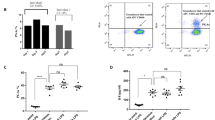Abstract
This study centers on the question of whether the phenomenon of leukocyte aggregation, which is typical to inflammatory conditions, is pathogenic per se. We examined patients and laboratory animals in whom the presence of aggregated leukocytes in the peripheral blood was documented by direct visualization and where, despite the presence of aggregated leukocytes, neither the patients nor the laboratory animals showed clinical or pathological evidence for leukoembolization. Our in vitro findings about the reversibility of the phenomenon of leukocyte aggregation help to explain the above-mentioned observations as well as the well-known daily clinical experience that, despite complement activation and other aggregatory stimuli, there is no clinical or pathological evidence for leukoembolization.
Similar content being viewed by others
References
Gallin, J. I. 1985. Leukocyte adherence-related glycoproteins LFA-I, Mol and p. 150, 95: A new group of monoclonal antibodies, a new disease and a possible opportunity to understand the molecular basis of leukocyte adherence.J. Infect. Dis. 152:661–664.
Crowley, C. A., J. T. Curnuttle, R. E. Rosin, J. Andre-Schwartz, I. Gallin, M. Klempner, R. Snyderman, F. S. Southwick, T. P. Stossel, andB. M. Babior. 1980. An inherited abnormality of neutrophil adhesion: Its genetic transmission and its association.N. Engl. J. Med. 302:1163–1168.
Kohl, S., T. A. Springer, F. C. Schmalstieg, L. S. Loo, andD. C. Anderson. 1984. Defective natural killer cytotoxicity and polymorphonuclear antibody-dependent cellular cytotoxicity in patients with LFA-1/OKM-1 deficiency.J. Immunol 133:2972–2978.
Fischer, A., A. Durandy, G. Sterkers, andC. Griscelli. 1986. Role of the LFA-1 molecule in cellular interactions required for antibody production in humans.J, Immunol. 136:3198–3203.
Kohl, S., L. S. Loo, F. S. Schmalstieg, andD. C. Anderson. 1986. The genetic deficiency of leukocyte surface glycoprotein Mac-1, LFA-1, p 150, 95 in humans is associated with defective antibody-dependent cellular cytotoxicity in vitro and defective protection against herpes simplex virus infections in vivo.J. Immunol. 137:1688–1694.
Fleck, L., andA. Murczynska. 1947. The phenomenon of leukergy.Arch. Pathol. 47:261–272.
Kariv, N., O. Medalia, andM. Aronson. 1983. Leukocyte agglomeration test to reveal bacterial infections in mice.Lab. Anim. Sci. 33:361–363.
Berliner, S., M. Abromovitz, N. Kariv, A. Weinberger, M. Yaron, G. Lavie, J. Pinkhas, andM. Aronson. 1985. The leukergy test in rheumatic diseases. New implications for an old test.Arthritis. Rheum. 28:899–903.
Berliner, S., S. Sclarovsky, G. Lavie, J. Pinkhas, M. Aronson, andJ. Agmon. 1986. The leukergy test in patients with ischemic heart disease.Am. Heart J. 111:19–22.
Berliner, S., D. Caspi.Y. Neuman, I. Ostfeld, M. Hod, M. Yaron, J. Pinkhas, andM. Aronson. 1987. Aggregation of white cells and c-reactive protein. A study on the relation between these two indices of the acute phase reaction.J. Clin. Pathol. 40:103–106.
Berliner, S., Z. Fishelson, S. Bruhis, H. Kaufman, J. Pinkhas, andM. Aronson. 1987. The phenomenon of leukergy. Induction and detection of leukocyte aggregation in whole human blood.J. Lab. Clin. Med. 109:575–583.
Lentnek, A. L., A. D. Schreiber, andR. R. Macgregor. 1976. The induction of augmented granulocyte adherence by inflammation. Mediation by a plasma factor.J. Clin. Invest. 57:1098–1103.
Hammerschmidt, D. E., T. K. Bowers, C. J. Lammi-Keefe, H. S. Jacob, andP. R. Craddock. 1980. Granulocyte aggregometry: A sensitive technique for the detection of C5a and complement activation.Blood 55:898–902.
Craddock, P. R., D. E. Hammerschmidt, C. F. Moldow, D. Yamada, andH. S. Jacob. 1979. Granulocyte aggregation as a manifestation of membrane interactions with complement: Possible role in leukocyte margination, microvascular occlusion and endothelial damage.Semin. Hematol. 16:140–147.
Jacob, H. S. 1983. Complement-mediated leukoembolization: A mechanism of tissue damage during extracorporeal perfusions, myocardial infarction and in shock. A review.Q. J. Med. 52:289–296.
Author information
Authors and Affiliations
Rights and permissions
About this article
Cite this article
Fadilah, R., Berliner, S., Yuli, I. et al. Instability of leukocyte aggregation: Lack of evidence for leukoembolization during various states of inflammation. Inflammation 12, 425–432 (1988). https://doi.org/10.1007/BF00919436
Issue Date:
DOI: https://doi.org/10.1007/BF00919436




